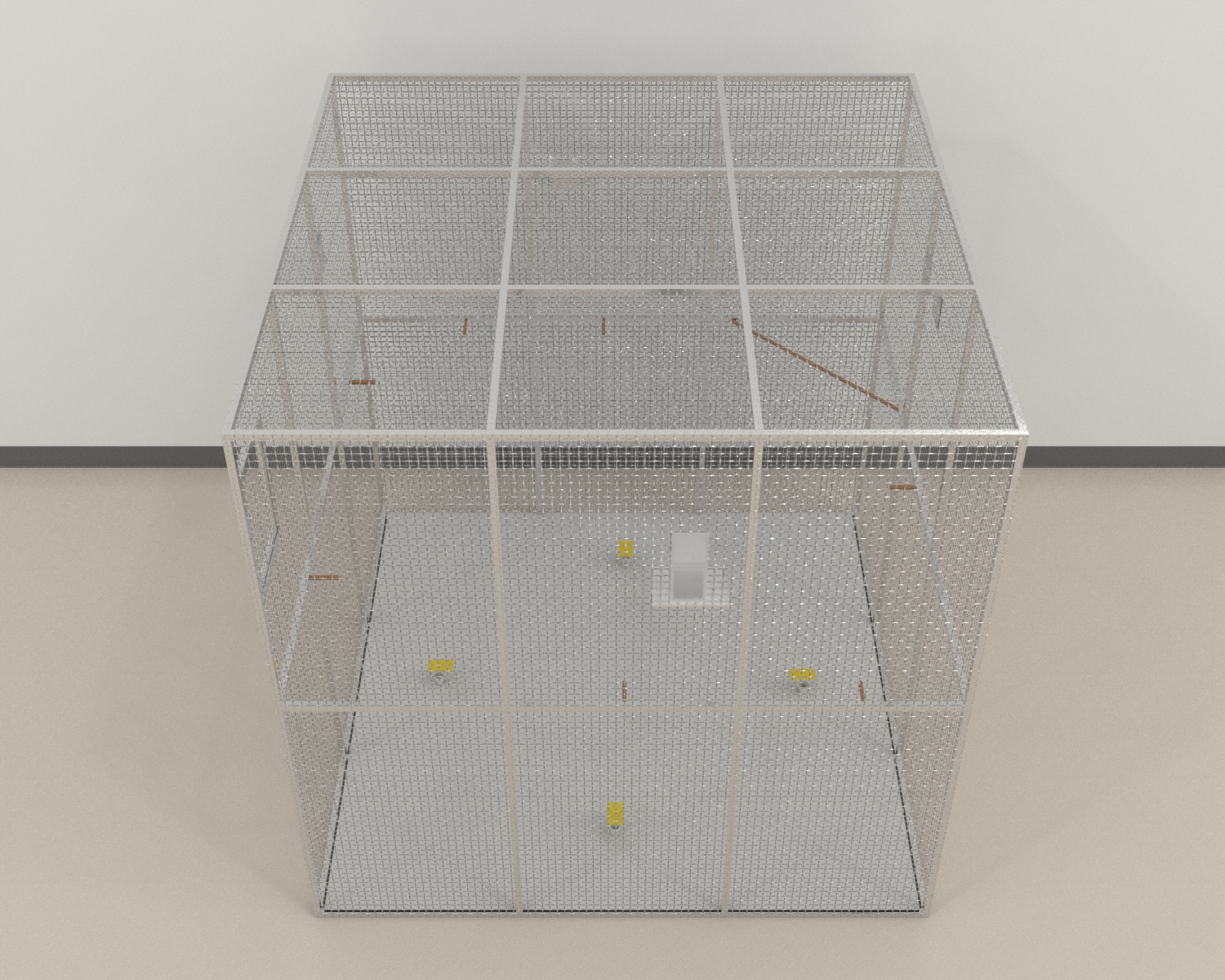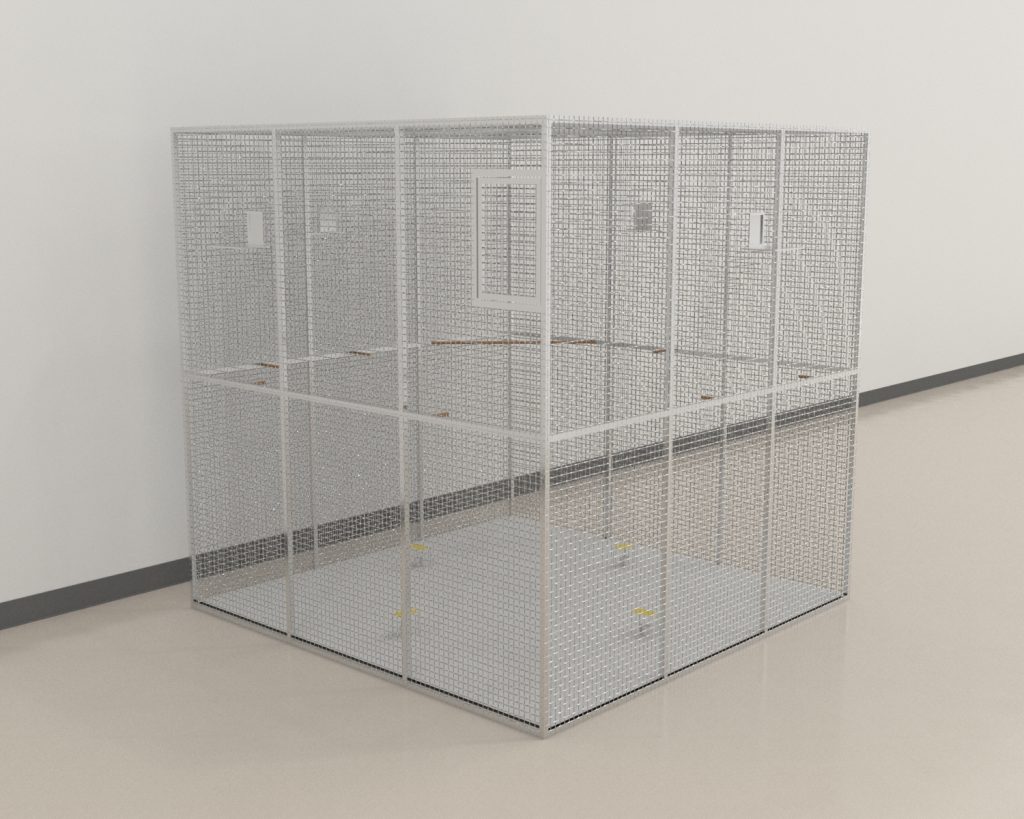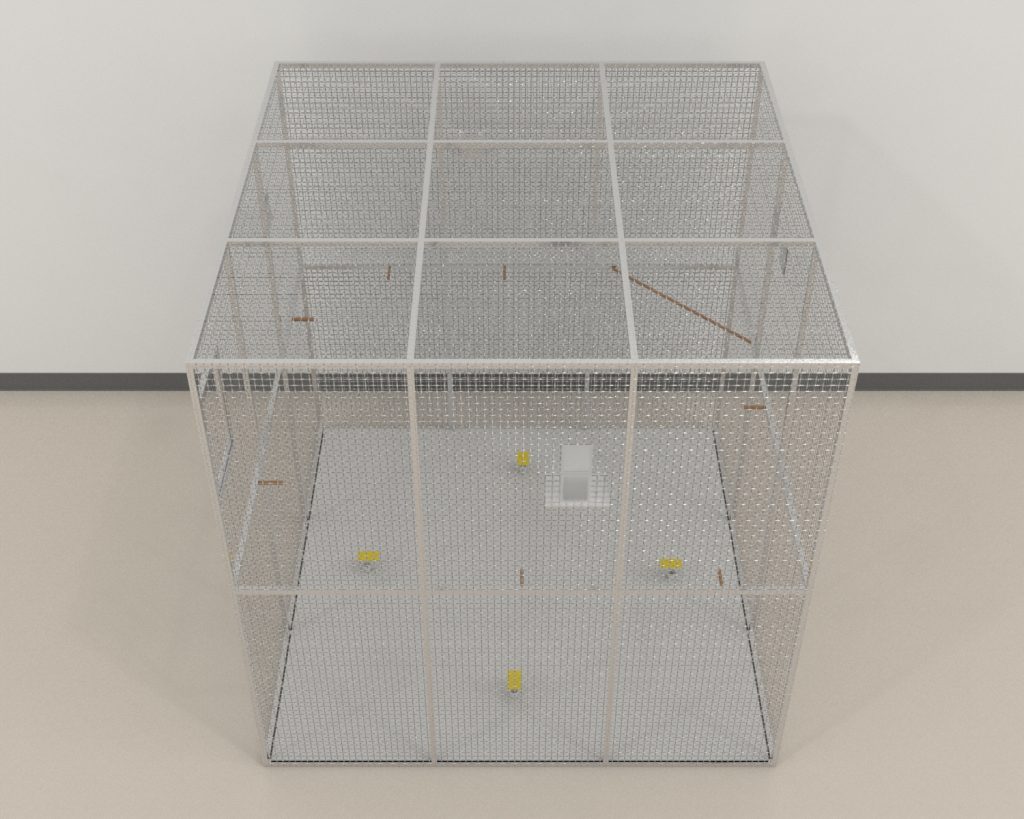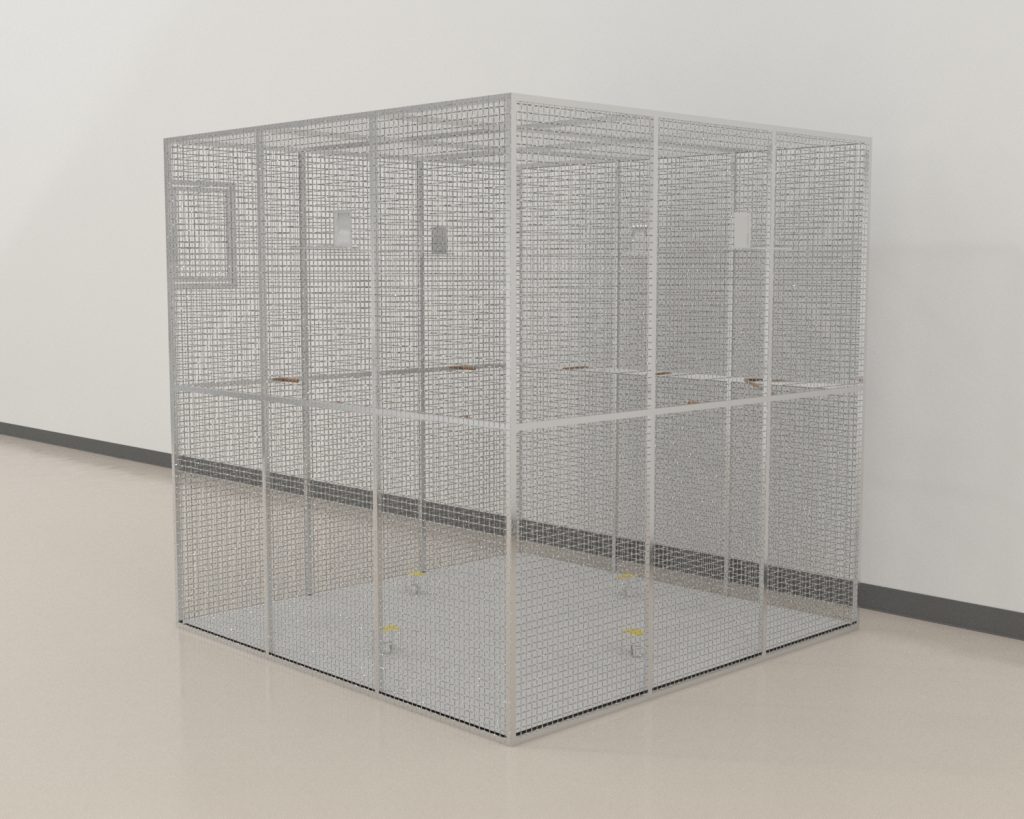Zebrafinch Chamber Maze was used to assess spatial memory and hippocampal function in a non-foodstoring songbird, the zebra finch.
The experimental set-up was a cubic aviary made of wire mesh. Each wall of the cage had a release site with a flap door. An acrylic platform on which the individual home cage of the experimental animal could be placed was fixed outside each release site. There was a long perch at one corner inside the aviary and seven short perches attached to the walls. The floor was covered with white paper.
The feeders were cylindrical white cups, consisting of the base part of a commercially available pet bird feeder each with a hollow arm allowing the bird to reach and eat the mixed grain. Each cup had a yellow carton sheet on its top that covered the arm so that the birds could not see the inside of the arm until they came close to the feeder.
Mazeengineers offers the Zebrafinch Chamber Maze.
Price & Dimensions
Zebrafinch Chamber Maze
$ 1990
+S&H- Length of cubic aviary: 180cm
- Width of cubic aviary: 180cm
- Height of cubic aviary: 180cm
- Length Flap door of release site: 10cm
- Width Flap door of release site: 7.5cm
- Length of perch inside aviary: 74cm
- Length of seven short perches attached to the walls: 9cm
- Diameter of feeders: 3.5cm
- Height of feeders: 3.5cm
- Width of arm of feeders: 1cm
- Height of arm of feeders: 3.5cm
- Length of yellow carton sheet: 5cm
- Width of yellow carton sheet: 8.5cm
Documentation
Introduction
The Zebra finch Chamber Maze is used to study spatial learning and memory in zebra finches. It is essentially a dry version of the Morris Water Maze for testing animals that are unable to swim. It consists of a cubic cage that has a flap door present on each wall, which serves as release site. Since the subjects are released into the maze at any of the four release sites, it prohibits the subjects from using local cues such as auditory, visual, or olfactory cues for task performance and relies on the subject’s spatial localization abilities. Extra maze cues can easily be provided on the walls of the experimental room.
The Zebra finch Chamber Maze can effectively be used to assess hippocampal function in zebra finches since the hippocampus is involved in spatial orientation and memory (Burgess, Maguire, & O’Keefe, 2002). The floor of the Zebra finch Chamber Maze contains feeders that can be made accessible or non-accessible. The subject’s discrimination and memory abilities are tested to remember the accessible feeder across trials. The Zebra finch Chamber Maze can easily be modified according to different experimental needs. It can be rotated, or the lower walls of the cage can be lined with white paper to further challenge the subject’s spatial orientation abilities. Since hippocampal lesions affect spatial learning and memory abilities, the Zebra finch Chamber Maze can be used to test the effect of hippocampal lesions on task performance. Moreover, the effect of pharmacological manipulations and diseases and disorders on spatial learning abilities can also be observed.
Other apparatuses that can be used to observe zebra finch behaviors include the Zebra finch Testing Cage, the Zebra finch Two-Compartment Cage, the Zebra finch Day Escape Maze, the Magnetic Compass, and the Mate Choice Apparatus 2.
Introduction
The Zebra finch Chamber Maze is used to study spatial learning and memory in zebra finches. It is essentially a dry version of the Morris Water Maze for testing animals that are unable to swim. It consists of a cubic cage that has a flap door present on each wall, which serves as release site. Since the subjects are released into the maze at any of the four release sites, it prohibits the subjects from using local cues such as auditory, visual, or olfactory cues for task performance and relies on the subject’s spatial localization abilities. Extra maze cues can easily be provided on the walls of the experimental room.
The Zebra finch Chamber Maze can effectively be used to assess hippocampal function in zebra finches since the hippocampus is involved in spatial orientation and memory (Burgess, Maguire, & O’Keefe, 2002). The floor of the Zebra finch Chamber Maze contains feeders that can be made accessible or non-accessible. The subject’s discrimination and memory abilities are tested to remember the accessible feeder across trials. The Zebra finch Chamber Maze can easily be modified according to different experimental needs. It can be rotated, or the lower walls of the cage can be lined with white paper to further challenge the subject’s spatial orientation abilities. Since hippocampal lesions affect spatial learning and memory abilities, the Zebra finch Chamber Maze can be used to test the effect of hippocampal lesions on task performance. Moreover, the effect of pharmacological manipulations and diseases and disorders on spatial learning abilities can also be observed.
Other apparatuses that can be used to observe zebra finch behaviors include the Zebra finch Testing Cage, the Zebra finch Two-Compartment Cage, the Zebra finch Day Escape Maze, the Magnetic Compass, and the Mate Choice Apparatus 2.
Apparatus and Equipment
The Zebra finch Chamber Maze consists of a cubic aviary that is made of wire mesh and measures 180 cm in length, 180 cm in width, and 180 cm in height. On each wall of the aviary, a release site with a flap door is present (10 x 7.5 cm). Outside each release site, a wooden platform is present that allows the individual home cage of the experimental animal to be connected to the Zebra finch Chamber Maze. Inside the maze, a long perch is present in one corner that measures 74 cm in length, while seven short perches that measure 9 cm in length are attached to the walls. The floor of the maze is covered with white paper in which feeders in the form of cylindrical white cups are placed. The base of the feeders consists of a commercially available pet bird feeder (3.5 cm in diameter, 3.5 cm in height). The feeders also include a hollow arm (1 cm wide, 3.5 cm high), which allows the bird to reach the food that has a yellow carton sheet (5 x 8.5 cm) placed on top to avoid the birds from seeing inside the arm until they come close to the feeder. A circular area (radius 12 cm) around each feeder is defined as the choice area.
Training Protocol
Clean the floor of the maze after each trial. Appropriately light the apparatus. A tracking and recording system such as the Noldus Ethovision XT can be used to assist with observations.
Habituation and Pre-training
Place mixed grain in all the feeders of the Zebra finch Chamber Maze. Attach the individual home cage of the subject to one of the release sites. Switch off the lights of the home cage. Release the subject into the Zebra finch Chamber Maze and allow it to explore it. Allow the subject to eat the food from a feeder for 2 minutes. Switch off the lights of the Zebra finch Chamber Maze and switch on the lights of the subject’s home cage. If the subject doesn’t return to its home cage, gently chase it back into it. Conduct three additional trials for the three other release sites in random order with an inter-trial interval of 90 minutes. Conduct habituation sessions for 3 to 4 days until the subject learns to eat the food from the feeders and then return to its home cage.
Zebra finch Chamber Maze Discrimination Training
Place mixed grain in all the feeders of the Zebra finch Chamber Maze; however, only allow access to one feeder by covering the three other feeders with transparent adhesive tape. Conduct training in the same manner as habituation sessions with each training session consisting of four trials, one for each release site in random order with inter-trial intervals between 90 to 120 minutes. Conduct one training session per day. Allow the same feeder to be the accessible feeder across all trials.
Zebra finch Chamber Maze Landmark Orientation Task
Cover the lower part of the cage walls with white paper or rotate the whole cage by 90°. Conduct trials in the same manner as the learned task.
Literature Review
Investigation of spatial memory and hippocampal function in zebra finches (Taeniopygia guttata)
Bischof, Lieshoff, and Watanabe (2006) investigated spatial memory and hippocampal function in zebra finches using the Zebra finch Chamber Maze. The subjects were first required to learn to eat the food from the feeders placed on the floor in the cage. Discrimination training was then performed in which only one feeder was accessible while the other feeders were covered with transparent adhesive tape. Trials were performed in which the subjects were released through each of the four release points in random order. The results indicated that the subjects readily learned the task since the time to reach the food and the number of errors made decreased from session to session. After two days, retention testing was performed to observe if the subjects remembered the learned task. It was observed that the subjects remembered the task after two days. After retention testing, the lower part of the cage walls was covered with white paper, or the cage was rotated by 90° to observe which landmarks the subjects could have used for orientation. The results indicated that the subjects mainly used cues from the lower part of the environment for orientation. Covering the lower part of the cage walls with white paper increased the time to reach the food as well as the number of errors. Rotating the aviary by 90° resulted in 40% of the subjects using extra-maze cues to find the food, 35% using cues at the aviary walls, and 25% did not make clear choices based on these cues. Another experiment was performed in which the birds received hippocampal lesions with injections of ibotenic acid either before acquisition or retention tests. A substantial decrease in performance was observed in the subjects that received hippocampal lesions before the acquisition of the task. In contrast, performance in control subjects that were not lesioned increased to 90% correct. In the subjects that received lesions before retention tests, a significant decrease in the number of correct choices were observed. Immediate early gene (IEG) experiments were also performed in which the subjects were divided into two groups of five. One group was classified as the learners and was required to learn that only one feeder has accessible food, while the other group (non-learners) performed trials in which all four feeders contained food. One hour after the 8th learning session, the birds were anesthetized, and their brains were removed and examined to investigate whether the IEG products Zenk and Fos were expressed within the hippocampus during learning. The results indicated that all the subjects from the learner group except one showed excellent staining of Fos and Zenk immunoreactive neurons. In contrast, all the subjects except one from the non-learner groups displayed an almost blank hippocampus.
Investigation of the effect of hippocampal lesions on spatial learning and memory in zebra finches.
Watanabe and Bischof (2004) investigated the effect of hippocampal lesions on the acquisition and retention of spatial learning and memory in zebra finches using the Zebra finch Chamber Maze. Twenty zebra finch males (Taeniopygia guttata) were used in the study. Habituation sessions were first conducted in which the birds were required to learn to eat from the feeder cups placed on the floor, and then testing began. During testing, the subjects were divided into five groups of four, which included acquisition, retention, and control groups. The acquisition group received bilateral hippocampal lesions, and the control group was only injected with an anesthetic but did not receive surgery. After 2 days, discrimination training was performed in which the subjects had to discriminate between an accessible feeder and three non-accessible feeders. The results indicated that the acquisition group did not show an improvement in learning performance while the control group was able to learn the spatial discrimination task. In the retention group and the retention control group, discrimination training was conducted immediately after habituation sessions. It was observed that both groups learned the task. After discrimination training, the retention group received bilateral hippocampal lesions, and the retention control group received Equithesin injections. After 2 days, retraining was conducted in both groups. It was observed that the control group remembered the task, but the lesion group was unable to maintain spatial discrimination learning and was also unable to relearn the task.
Data Analysis
The following parameters can be observed using the Zebra finch Chamber Maze:
- Number of visits to each feeder
- Time taken to reach a feeder after entering the maze
- Number of incorrect visits to a feeder
- Number of incorrect visits to a feeder until the correct feeder was found
Strengths and Limitations
Strengths
The Zebra finch Chamber Maze allows the investigation of spatial orientation abilities in zebra finches. It consists of a cubic aviary that has a release point on each wall to allow the subjects to be released from different positions across trials. Releasing the subjects from different positions prevents the subjects from using local cues for task performance. Feeders are placed on the floor of the cage that can be used to access food or made inaccessible by covering them with transparent adhesive tape. The Zebra finch Chamber Maze can also be rotated to further challenge the subject’s spatial orientation abilities. In addition, the Zebra finch Chamber Maze can be modified by lining the lowers walls of the cage with white paper. The Zebra finch Chamber Maze is essentially a dry version of the Morris Water Maze that can be used to test non-swimming animals. Extra maze cues can easily be provided on the walls of the testing room.
Limitations
Training is highly important for task performance. Factors such as age, gender, and strain of the subjects may affect task performance. The exploratory drive of the subjects is necessary for the completion of the task. The presence of unintentional stimuli may affect the way the subject performs the task.
Summary
- The Zebra finch Chamber Maze is used to observe spatial learning and memory in zebra finches and also challenges their spatial orientation abilities.
- It is essentially a dry version of the Morris Water Maze.
- It consists of a cubic aviary that has a flap door present on each wall that serves as release sites. On the floor of the aviary, four feeders are present.
- The Zebra finch Chamber Maze can be used to assess hippocampal function in zebra finches and also be used to test the effect of hippocampal lesions on spatial learning and memory.
References
- Bischof, H. J., Lieshoff, C., & Watanabe, S. (2006). Spatial memory and hippocampal function in a non-foodstoring songbird, the zebra finch (Taeniopygia guttata). Reviews in the neurosciences, 17(1-2), 43–52. https://doi.org/10.1515/revneuro.2006.17.1-2.43
- Burgess, N., Maguire, E. A., & O’Keefe, J. (2002). The human hippocampus and spatial and episodic memory. Neuron, 35(4), 625–641. https://doi.org/10.1016/s0896-6273(02)00830-9
- Watanabe, S., & Bischof, H. J. (2004). Effects of hippocampal lesions on acquisition and retention of spatial learning in zebra finches. Behavioural brain research, 155(1), 147–152. https://doi.org/10.1016/j.bbr.2004.04.007
Request a quote
"*" indicates required fields




